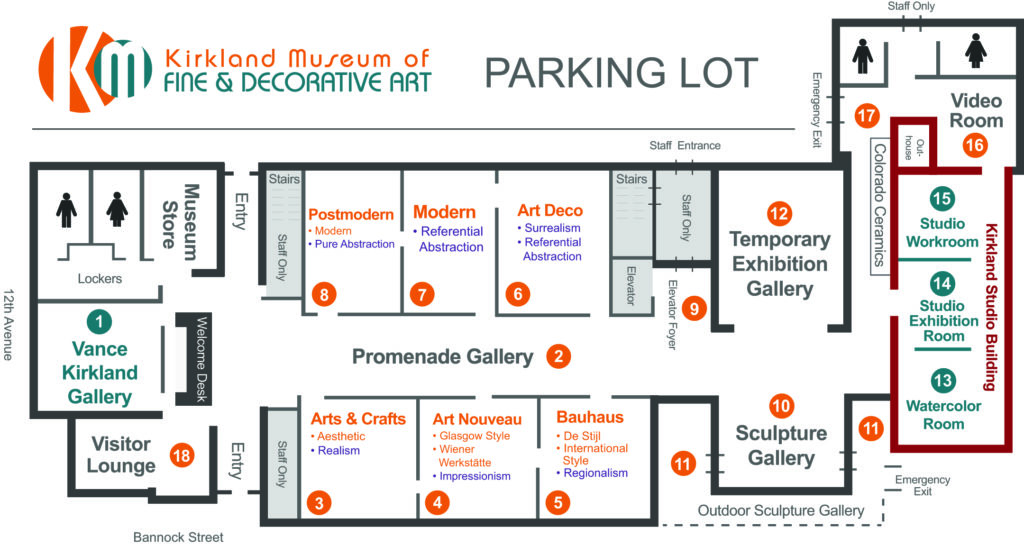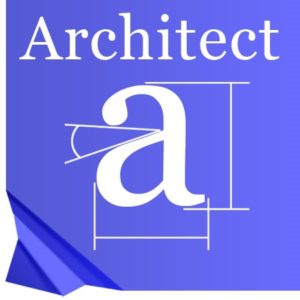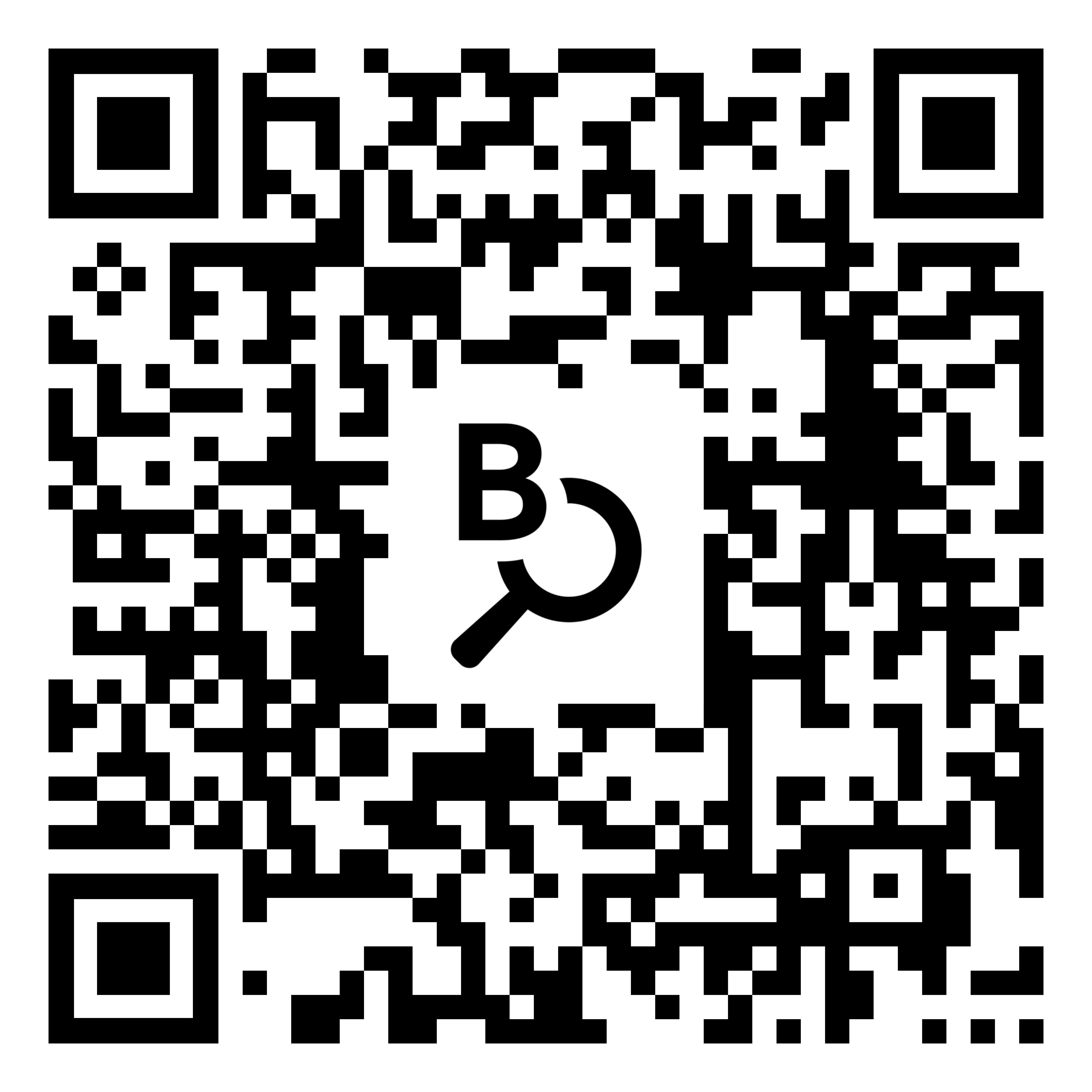Below are some helpful digital resources for visitors, several of which are also available at the Welcome Desk. Use this page to prepare for your visit, or bookmark the page on your smartphone for use in the galleries!
Menu
Bloomberg Connects Audio Guide
Explore Kirkland Museum with our free mobile guide and audio tour, available on Bloomberg Connects, the free arts and cultural app. You can take an introductory audio tour through the galleries and take audio tours of temporary exhibitions, all on your own smartphone. Download the free app today and start exploring!

Map

Introduction
Welcome to Kirkland Museum of Fine & Decorative Art!
In order to best enjoy Kirkland Museum, please:
DO
- Leave coats, bags, backpacks and water bottles in a complimentary locker
- Be aware of your personal space
- Take photographs for your personal use, without flash
- Only sit on benches marked “Visitor Seating”
- Ask questions and give us feedback
DO NOT
- Touch the artwork or objects
- Bring food or drink
- Sit on furniture (unless marked “Visitor Seating”)
- Take flash photographs or use images for publication without express permission
Kirkland Museum was founded by Director & Curator, Hugh Grant, with extensive support from Merle Chambers, philanthropist and Vice President of the Kirkland Museum Board.
- Hugh Grant was a close family friend of Vance Kirkland (1904–1981), an important Colorado artist and the Museum’s namesake.
- At Kirkland’s death in 1981, Grant inherited most of his estate, which included Kirkland’s own paintings, his small collection of decorative and Colorado art and the studio & art school building.
- Nearly all of the artwork and objects were collected by Hugh Grant and Merle Chambers, with a small number from Vance Kirkland. Others were gifts or donations.
- The Museum originally opened in 2003 at 13th Avenue & Pearl Street. The current location opened in March 2018.
- Funding for the building was generously provided by Merle Chambers Fund.
Kirkland Museum has three principal collections
International Decorative Art
- Decorative art includes functional objects such as furniture, ceramics, tableware and glassware.
- All of the major modern design movements are represented from about 1870 to the present: Arts & Crafts, Aesthetic, Art Nouveau, Glasgow Style, Wiener Werkstätte, De Stijl, Bauhaus, Art Deco, Modern, Pop Art and Postmodern.
Colorado & Regional Art
- We show the full arc of Colorado and the surrounding states’ art history with works from about 1845 to the present.
- The collection includes the work of many painters, sculptors and ceramists Kirkland knew or taught.
Vance Kirkland (1904–1981)
- In Vance Kirkland Gallery 1, see all five of Kirkland’s painting periods spanning from realism to surrealism to abstraction.
- Vance Kirkland’s paintings anchor the Museum on both ends; in the Vance Kirkland Gallery 1 and in the studio & art school building, where all of the paintings are by Kirkland.
- Kirkland completed about 1,200 paintings during his 55-year career. Kirkland Museum owns about half of his known paintings and many of his prints and drawings.
All three collections are displayed in salon style to allow visitors to view fine art alongside decorative art and time travel through about 150 years of art.
- Salon style means fine art (paintings and sculpture) is shown with decorative art.
- Each gallery includes groupings of furniture, lamps, phones, radios, glassware and textiles alongside fine art from the same era.
- The central Promenade Gallery 2 features vignettes or groupings of furniture and paintings that represent the art and design movements or styles featured in the closest room. The first gallery on the right is Arts & Crafts Gallery 3.
- Galleries 3 through 8 are displayed in roughly chronological order, allowing visitors to time travel from the Arts & Crafts Movement in the 1870s (with paintings in the style of Realism by Colorado artists) all the way to more recently made work in Postmodern Gallery 8.
- Next visit the Indoor Sculpture Gallery and the Temporary Exhibition Gallery.
The brick building at the end of the Promenade Gallery 2 was used by Vance Kirkland for over 50 years as a studio & art school.
- 1904 – Vance Kirkland was born in Convoy, Ohio and studied at the Cleveland School of Art.
- 1929 – Kirkland moved to Denver to serve as the director of the current school of art at the University of Denver (DU).
- 1932 – Kirkland parted ways with DU and opened the Kirkland School of Art on Pearl Street.
- 1946 – Kirkland returned to DU until his retirement in 1969, using the Pearl Street building as his personal art studio until his death in 1981.
- Throughout his life, Kirkland was influential in the Denver arts scene, served in a number of capacities at the Denver Art Museum and created an extensive body of work.
The brick studio building is the heart of the Kirkland Museum experience.
- To honor its significance, the entire structure was moved from its original location at 13th and Pearl Street in 2016. Merle Chambers provided the inspiration to move the Kirkland studio building.
- The studio is oriented in the same direction as in its former location. For example, the skylights still face north, letting in optimal light for painting, as they did in Kirkland’s time.
- Built in 1910–1911, the studio building was commissioned by artist Henry Read to house his Students’ School of Art.
- Kirkland Museum joins the studios of artists such as Jackson Pollock & Lee Krasner, Thomas Hart Benton, Grant Wood, Charles Russell and Georgia O’Keeffe as a member of Historic Artists’ Homes and Studios, a program of the National Trust for Historic Preservation.
- Though the studio may look and feel like a residence, it was never a home.
About the Architecture
- Jim Olson, FAIA, founding principal and owner of Seattle-based Olson Kundig, designed the Museum. Learn more here!
Style and Movement Decals
Find each style listed above on gallery wall where style or movement begins. Each style or movement continues around the rest of the room until there is another sign.
These decals are color-coded by collection. Decorative art movements and styles are orange. Colorado & regional art styles are purple and Vance Kirkland’s periods are turquoise.
What is the “Architect” tag on the object labels?

This blue “a” signifies that the designer of the work was also an architect.
Did you know that many designers were trained as architects? Some architects designed furnishings for their buildings in order to create one unified look. In German this is called Gesamtkunstwerk, a total work of art.
Currently more than 650 objects by 100 architects are on view.
The architects with work in the collection come from 25 different countries and span all of the design periods represented in the Museum, from Arts & Crafts to Modern and Postmodern.
Search Collection Highlights by Gallery
Did you know that you can search collection highlights featured on our website by their location? On the search page, select a gallery or room under “Filter by Display Location” to see featured works in that room!

